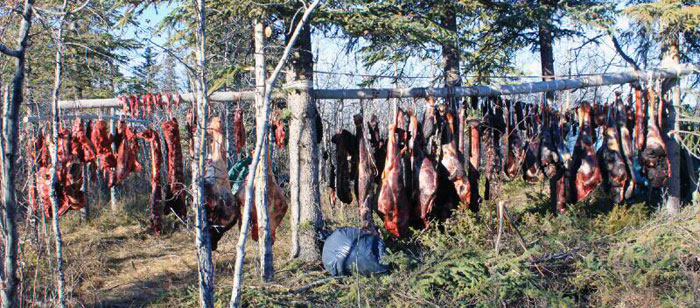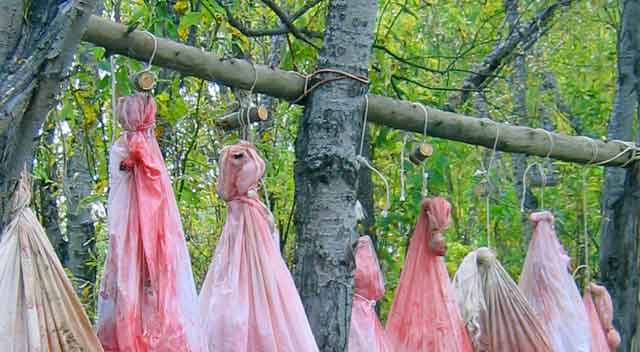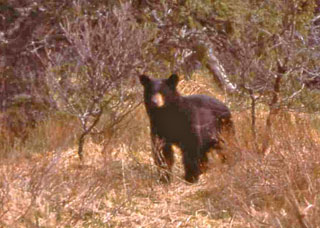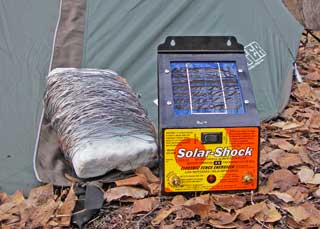Proper meat care at the kill site is just the beginning. To keep your meat from spoiling in camp or during transit, you need to pay attention to some critical details. It's not difficult, it just requires time and some effort.

Care of Meat in Camp
There's an old saying that goes, "The fun stops when you pull the trigger". This is especially true on a remote Alaska hunt where there's a risk of losing hundreds of pounds of game meat from improper care in camp. Taking care of game meat in camp is much easier than the grueling work of packing it out of the field through alder thickets and muskeg swamps, but sometimes this is where the process breaks down. Hunters are tired and they figure that as long as it's in camp, everything will work out fine. This is far from the case.
Setting up the Meat Pole
As was mentioned on our Introduction to Meat Care, keeping meat cool and dry are two essential parts of proper care. Hanging the meat is the best way to assure both ventilation and cooling. Cut a pole at least five or six inches in diameter and lash it to two trees. If the pole is more than five feet long, you may have to lash a vertical support pole in the middle, to prevent sagging. This is particularly true with moose, with quarters that can weigh 120 to 160 pounds each.
The Loop and Toggle Method
It takes a lot of rope to hang a moose. If you're using 1/4" braided nylon, you can figure on around 100' of rope. Use the Loop and Toggle method to hang the meat and you'll use less, save time, and make your job much easier. Cut eight sections of rope, 5' in length each. Tie a loop in each end and store these in your meat care gear in camp or on the boat (float hunts). When it's time to hang the meat, slip one loop around the shank bone on each quarter (over the game bag, of course), and have your partner hold the bag up to the meat pole. Toss the other end of the rope over the pole, push the standing end through the loop, and insert a toggle in the bight. Cut some short sections of willow limb to use for toggles.

Using the Loop and Toggle method means you don't have to tie, cut, and re-tie ropes every time you hang the meat. It also speeds up the time it takes to hang it and take it down. Just leave the ropes looped on the meat bags during transport.
Loop and Toggle Method (AOS Video)
When There Are No Trees
In treeless areas it will not be possible to hang the meat. Build a brush pile at least four feet thick and place the bagged meat on top of it, ensuring that no meat bags are touching each other. Bags that are in contact with other bags will generate spoilage-causing moisture between them. The weight of the meat will compress the brush down to about two feet or so, but the brush will allow air to flow beneath the meat, in order to facilitate drying and cooling. Place additional brush atop the meat before securing your tarp in place, assuring that the tarp is not in contact with the meat and that the edges of it are high enough to assure good ventilation. In tundra where there is no brush, your only option may be to lay the meat bags across tundra hummocks, allowing for airflow beneath the quarters. In this situation you will have to turn the bags over every few hours, because they will develop moisture at the point of contact with the hummock. Some hunters may prefer using an awning of some sort to cover the ground cache. A good choice is the Kifaru Para-Tarp, which offers a tapered footprint of 9.6'x8'x5'. This is fairly tight for a moose, but perfect for deer, goat, Dall sheep or caribou. A better choice for moose is the Moss Outfitter Wing, which is 19' long.
Cold Weather Considerations
If meat is allowed to freeze before rigor mortis sets in, it will be rubbery in texture. This is because premature freezing locks in higher pH level, which releases moisture from the muscle fibers prematurely and makes the meat tough. To prevent this, meat must cool in a controlled fashion, until the pH level drops to about 5.3 or so, which allows the meat to hold moisture and become tender. That takes about eight hours from the time the animal is killed. If you are concerned about premature freezing, simply cover your bagged meat with the hide overnight. In winter conditions, consider covering it with the hide and burying it in the snow. When you dig it out the next day it will still be unfrozen and prime. After that it is fine to allow it to freeze.
What to do with Spoiled Meat
Alaska law requires all edible meat to be salvaged from the animal, and transported out of the field. If meat becomes spoiled in the field, you still have a responsibility to salvage it. If the spoilage is limited to one bag, as is sometimes the case with bone sour, keep that bag isolated from the others to prevent cross-contamination. Then transport the meat out of the field as usual. During transport, separate contaminated meat from uncontaminated meat by using a tarp or trash bags to form a barrier between the bags if necessary. If you're flying out of the field in a floatplane, it may be possible to put contaminated meat in the floats. Under no circumstances are you allowed to abandon meat in the field because of spoilage!
Keeping Bears Away
Most hunters new to Alaska are apprehensive about bear problems in camp. Most experienced Alaska hunters are aware of bears and know that the chances of having trouble are remote, but they observe some basic practices in the field that diminish the risks of a dangerous encounter.
It's relatively rare for bears to come into a human camp to raid the meat cache. The amount of activity in the camp, and the saturation of human odors in the area are usually enough of a deterrent to keep them at a distance. Chances are, you'll never see them.
At the same time, it is foolish to camp in bear country and not be prepared do deal with a situation involving a bear in or near camp. Each bear has its own personality, and while most are reclusive, some are certainly troublemakers. The bear in the photo above came into camp multiple times until the food was hung up high in a tree near camp. The primary defense is common sense. Position your meat cache where you can see it from camp, yet close enough to allow you to warn bears of your presence. Next, use any and all non-lethal means to deter a bear from getting into the meat. Make noise, fire a weapon into the ground nearby, and generally make the bear aware of your presence. Finally, ensure that you have a firearm that's adequate to kill a bear if necessary. The Alaska Hunting Regulations do not allow you to shoot a bear for which you do not have a proper tag, however state statutes allow the taking of a bear "in defense of life and property" (commonly known as "DLP"). The term "property" indicates permanent or temporary dwellings (including tents), means of conveyance (airplanes, boats, rafts, ATVs, etc) or "other property of substantial value necessary for the livelihood or survival of the owner" (5 AAC 92.410). For more on this question visit this issue in our "Ask a Wildlife Trooper" forum. If you do kill a bear in defense of life and property, you are required by law to skin the bear and bring out the hide and skull; both become the property of the state of Alaska. Upon returning the hide (with all claws attached) and the skull to the Alaska Department of Fish and Game, you are required to submit a "Defense of Life or Property Game Animal Kill Report" to ADF&G (the address is listed on the form). Alaska's DLP law does not permit you to shoot a bear that is getting into your meat cache. The only legal way you can take a bear that is getting into the meat is if bear season is open and you have a valid tag.
 Electric Fences
Electric Fences
Once the meat is in camp, some hunters prefer an electric fence around the meat storage area; fences seem to be very effective in keeping bears out of the meat and one can be rigged up for around a hundred dollars. That's cheap enough insurance that you might also consider one around your kitchen or sleeping area. Some fence setups use D-cell batteries, and some, like the one to the left, use solar power to charge the batteries during daylight hours.
Post-Hunt Issues
You can do an excellent job taking care of the meat in camp and on the river, but still lose it to spoilage. Delays in transport, improper packaging, or mishandling can all contribute to ruined meat. Care to a few details can prevent this.
Transporting from the Field
On fly-out hunts where meat may be flown out of camp without the hunter aboard the aircraft, a Transfer of Posession / Permission to Transport Formmust be filled out. A copy of this form can be found on the back page of the Alaska Hunting Regulations, but you don't have to use that particular form. You just need to have a copy of the information, which can be written down on a sheet of paper. One copy goes with the meat, and the other stays with the hunter. Alaska law allows hunters to donate meat to another party, but the same form needs to be filled out, and a copy is transferred with the meat while the hunter retains a copy. Failure to produce a copy of this form after meat has been transferred is a violation of the regulations and you can be cited. Because portions of the meat may be transferred a little at a time, it's wise to bring several blank copies of the form into the field with you.
Airplane Dynamics
If you're transporting by air from the field, your pilot will appreciate it if you lay a clean tarp down on the floor of the aircraft before helping load the meat. Otherwise blood gets on the floor of the aircraft and it is hard to clean. Also because meat is heavy and dense, most pilots prefer to load it first, then load gear on top of it. Use caution to avoid loading fuel cans, outboard motors or other items on top that may leak and contaminate the meat.
Mid-Hunt Meat Hauls
Some air charters offer to stop by and collect any game meat that is ready to transport, before the scheduled pick-up date. This can be a real benefit to the air service in that it breaks up their loads more evenly. It's also advantageous as far as meat care, assuming advance arrangements have been made with the air service to take it to a local processor or to a chill / freeze facility where it can be held until the hunters return to collect it. In the case of village-based air charters that may not have such facilities available, it may be better to simply hold on to the meat in the field, where you have more time and resources to devote to its care. There have been cases where hunters have arrived from the field to find their meat stacked on a pallet in the sun, where it sat for several days after being hauled out of the field. Speak with your air service about mid-hunt meat hauls to ensure that 1) they will have your meat held in cold storage, 2) you know what day(s) they may be in the area, and 3) you know the appropriate ground signals you should use to let them know you have meat available for pickup.
Special Considerations on Float Hunts
Float hunting presents unique challenges with respect to meat care, but most are dealt with by good planning and some extra effort.
Float hunters can get lazy over time. Long days on the river, often involving the heavy work of dragging meat-laden boats through shallow water, arduous rounds of downstream scouting on foot, and heavy rowing sessions tax the body's reserves to the point that by the time you make camp, you're almost spent. Don't give in to fatigue! Every time you camp the meat must be removed from the boat and hung from a meat pole or placed in a ventilated location. If you leave it on the boat, condensation will develop between the bags, creating a high probability of spoilage from bacterial contamination.
Recommended Gear List
The following items are recommended by this site as a result of years of collective experience in the field working with Alaska game.
- Helle Nying knife (2 each)
- Havalon Piranta knife (1 each, with extra blades)
- E-Z Lap Model M diamond sharpener with sheath (1 each)
- Leatherman Wave multi-tool (1 each)
- ARS GR-17 folding saw, with extra blade (1 each)
- This email address is being protected from spambots. You need JavaScript enabled to view it., enough for intended harvest
- Estwing Camper’s Axe (1 each)
- Heavy-Duty Game Bags
- Citric Acid Powder
- UDAP electric fence kit for bear protection
- Flagging Tape
Additional Resources on Meat Care
- Alaska Field Care Handbook (two-part e-book by Michael Strahan)
- Field Care Handbook (book by Duncan Gilchrist)
- Float Hunting Alaska's Wild Rivers (book by Michael Strahan; contains extensive meat care section)
(ADFG Video)
